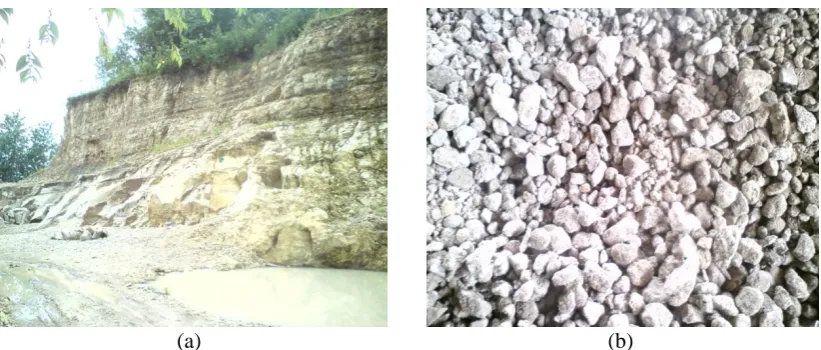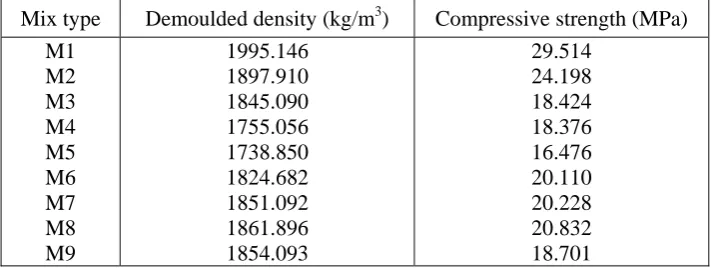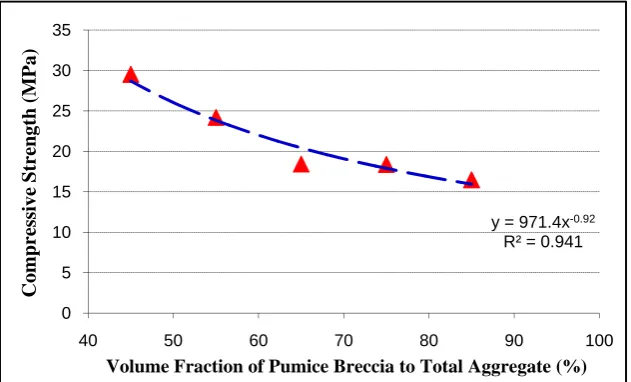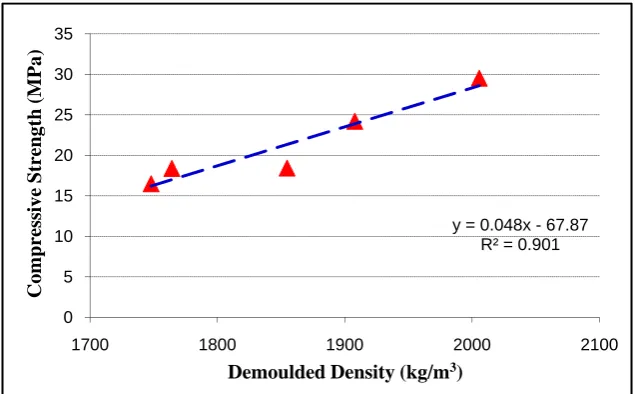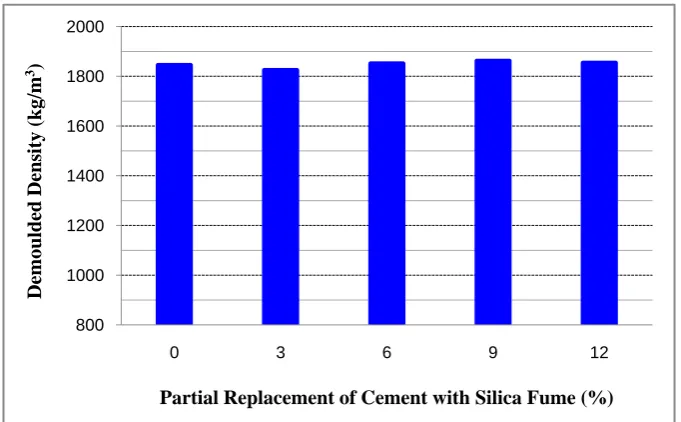EXPERIMENTAL STUDY ON THE POTENTIAL USE OF PUMICE
BRECCIA AS COARSE AGGREGATE IN STRUCTURAL
LIGHTWEIGHT CONCRETE
Slamet Widodo1, 3, Iman Satyarno2, Sri Tudjono3
1
Department of Civil Engineering and Planning, Yogyakarta State University, Yogyakarta, Indonesia
2
Department of Civil and Environmental Engineering, Gadjah Mada University, Yogyakarta, Indonesia
3
Department of Civil Engineering, Diponegoro University, Semarang, Indonesia *Corresponding E-mail: swidodo@outlook.com
Received 10 November 2013; Revised 10 January 2014; Accepted 17 January 2014
Abstract
Lightweight concrete application in construction works is growing rapidly in these recent years due to its advantages over ordinary concrete. In this research, pumice breccia which can be found abundantly in Indonesia is proposed to be utilized as the coarse aggregate. This study experimentally examines the effects of coarse pumice breccia aggregate content and partial replacement of portland cement with silica fume on the demoulded density and compressive strength of pumice breccia lightweight concrete. Nine groups of concrete test specimens were investigated. Test results indicate that the demoulded density of lightweight concrete tends to decrease, inversely proportional to the addition of the volume fraction of pumice aggregate into the mixes. Structural lightweight concrete can be produced when the lightweight concrete mixtures utilized the pumice breccia as coarse aggregate and its volume fraction range between 55% and 75% to the total volume of aggregate. The compressive strength of structural lightweight concrete can be improved proportionally up to 13.07% when the portland cement was partially replaced with silica fume up to 9% by weight of cement.
Keywords: Hardened properties, Lightweight concrete, Pumice breccia, Silica fume
1.0 Introduction
Lightweight concrete (LWC) application for construction works has been widely used in these recent years both for structural and non-structural purposes due to its advantages over ordinary concrete. The utilization of lightweight concrete in modern construction works is increasing, owing to the advantage that its lower density results in a significant benefit in terms of load bearing elements of smaller cross sections and a corresponding reduction in the size of the foundation. Furthermore, the reduction in weight by the use of lightweight concrete will be advantageous, especially for building structures which are located in seismic zones.
The maximum density of concrete which allowed to be categorized as lightweight concrete in some European construction codes is limited to 1850 kg/m3 [1], while the limitation in Indonesian National Standard is 1900 kg/m3 [2], compared with that of 2400 kg/m3 for normal weight concrete (NWC). According to most of the concrete structures codes in some American, European and Asian countries, mixtures of uncrushed and/or crushed grains for natural and/or manufactured minerals can be classified as lightweight aggregate when it has dry loose bulk density less than 1200 kg/m3 for fine aggregate and 1000 kg/m3 for coarse aggregate [1-6].
category is structural lightweight concrete which can be utilized for reinforced concrete. According to the classification given by ACI 213R-03, Lightweight concrete for structural purposes is defined as concrete with a density range of 1120 to 1920 kg/m3 and strength grade not less than 17 MPa [6].
Pumice breccia is a type of clastic sedimentary rocks which has a relatively low density and low mechanical strength. Crushed pumice breccia has a dry-loose bulk density less than 1000 kg/m3, therefore, can be classified as lightweight aggregate. Unfortunately, the Los Angeles abrasion test result shows that it has more than 50% weight loss thus pumice breccia does not satisfy to be used as concrete aggregate. Based on the above mentioned facts, optimization of pumice breccia content in structural lightweight concrete mixtures need to be determined.
In this research, pumice breccia which can be found abundantly in Indonesia proposed to be utilized as the coarse aggregate for the development of structural lightweight aggregate concrete. The main objectives of this research are: (1) to optimize the composition between natural sand that is used as fine aggregate and pumice breccia which is proposed to be utilized as coarse aggregate to develop lightweight aggregate concrete mixtures which aimed to meet the technical specification for structural applications, and (2) to examine the effects of mineral admixtures addition on the hardened properties of lightweight concrete containing pumice breccia as coarse aggregate.
2.0 Literature
Review
Pumice breccia is a type of coarse grained pyroclastic rocks with its breccia fragments dominated by pumice with highly variable shape and size, white-gray color, and its matrix consisting of limestone with amorphous silica. Pumice breccia is formed by the volcanism activity. Therefore, it can be found abundantly along the volcanic line in Indonesia. The location that had been identified as the largest pumice breccia deposit area is Semilir Formation. The Semilir Formation is typically originated from products of a very explosive volcanic activity. It is a widespread mountainous area at the southern part of Java Island. The formation is widely distributed from the west side at Pleret and Piyungan areas in Bantul Regency, Special Province of Yogyakarta until Eromoko area in Wonogiri Regency, Central Java Province in the east [7]. Based on the official data which is released by the center of investation resources development in the Indonesian Ministry of Public Works, the Special Province of Yogyakarta has 2.50 billion m3 deposit of the pumice breccia which is located in Bantul, Gunung Kidul and Sleman region [8]. Pumice breccia has a relatively low density, therefore; it shows its potential to be used as lightweight concrete aggregate.
(a) (b)
ACI 213R-03, Guide for Structural Lightweight Aggregate Concrete defines structural lightweight-aggregate concrete made with structural lightweight aggregate as defined in ASTM C 330. The concrete has a minimum 28-day compressive strength of 2500 psi (17 MPa), an equilibrium density between 70 and 120 lb/ft3 (1120 and 1920 kg/m3), and consists entirely of lightweight aggregate or a combination of lightweight and normal-density aggregate. From the standpoint of workability and other properties, it is a common practice to use normal-weight sand as fine aggregate, and to limit the nominal size of the lightweight coarse aggregate to a maximum of 19 mm. According to ASTM C 330, fine lightweight and coarse lightweight aggregates are required to have a dry-loose weight not exceeding 1120 kg/m3 (70 lb/ft3) and 880 kg/m3 (55 lb/ft3), respectively [9]. Most of lightweight concrete has lower compressive strength compared to normal concrete. In order to improve the concrete compressive strength, mineral admixtures addition is one of the proven methods that can be easily applied.
Silica fume (SF) is a type of mineral admixture. It is a byproduct of the silicon and ferrosilicon industry. The reduction of high-purity quartz to silicon at temperatures up to 2000 ºC produces SiO2 vapours, which oxidizes and condense in the low-temperature zone to tiny particles consisting of non-crystalline silica. Silica fume is a very reactive pozzolanic material because of its extreme fineness and very high amorphous silicon dioxide content. Mechanism of silica fume in concrete can be described basically under three roles: (i) pore-size refinement and matrix densification, (ii) reaction with free-lime, and (iii) cement paste–aggregate interfacial refinement. In concrete, the characteristics of the transition zone between the aggregate particles and cement paste play a significant role in the cement-aggregate bond. Silica fume addition influences the thickness of transition phase in mortars and the degree of the orientation of the CH crystals in it. The thickness compared with mortar containing only ordinary Portland cement decreases and reduction in the degree of orientation of CH crystals in transition phase with the addition of silica fume. Hence mechanical properties and durability are improved because of the enhancement in interfacial or bond strength [10]. A higher ultimate strength can be obtained by designing a mix with a low initial strength gain and cementitious additions. This is partially due to avoidance of micro-cracking associated with high thermal gradients. This effect can be facilitated if strength compliance is measured at 56 instead of 28 days [11].
In these recent years, there were several researchers who studied lightweight concrete using pumice aggregate [3-5]. None of those researchers who specifically determined the optimum content of the coarse aggregate utilizing pumice breccia as coarse aggregate to produce structural lightweight concrete. Therefore, this research aimed to determine the optimum content of coarse pumice breccia aggregate for structural lightweight concrete production and attempt to improve its compressive strength by applying partial replacement of portland cement with silica fume.
3.0 Methodology
3.1 Materials and Mix Proportion
The mixtures were prepared with blended cement which satisfies to the requirements in the Indonesian Standards [10]. The detail of its chemical compounds is presented in Table 1.
Table 1: Chemical Composition of Portland Cement
Chemical Compounds SiO2 Al2O3 Fe2O3 CaO MgO SO3 LoI
Mass (%) 23.13 8.76 4.62 58.66 0.90 2.18 1.69
were pre-wetted and submerged in water in 24 hours and then air-dried to be in saturated surface dry condition before mixing process. Well-graded natural sand with specific gravity of 2.65 was employed as a fine aggregate. Silica fume, and naphthalene formaldehyde sulfonate based high range water reducer (HRWR) complying ASTM C 494-92 Type F were also utilized as concrete admixtures in this research. Detail of mixes proportion in this research can be found in the following Table 2.
Table 2: Mixture Proportion of Nine (9) Series of Lightweight Concrete Mixtures
Mix Type
Cement (kg/m3)
Silica Fume (kg/m3)
Water (kg/m3)
W/B Pumice breccia (kg/m3)
Sand (kg/m3)
HRWR (lt/m3)
M1 500 0 225.00 0.45 420.101 846.252 4.70
M2 500 0 225.00 0.45 513.456 692.388 4.70
M3 500 0 225.00 0.45 606.812 538.524 4.70
M4 500 0 225.00 0.45 700.168 384.660 4.70
M5 500 0 225.00 0.45 793.524 230.796 4.70
M6 485 15 (3%) 225.00 0.45 606.812 538.524 4.70
M7 470 30 (6%) 225.00 0.45 606.812 538.524 4.70
M8 455 45 (9%) 225.00 0.45 606.812 538.524 4.70
M9 440 60 (12%) 225.00 0.45 606.812 538.524 4.70
3.2 Experimental
Works
Hardened properties of concrete mixes were evaluated based on its demoulded density and compressive strength. In order to determine the density on demoulding as declared in BS EN 8500:1 2006 [12], specimens’ weight and dimensions were measured 24 hours after concrete casting. The compressive strength of all concrete variants was evaluated after the hardened concrete specimens were cured with 56 days water immersion. Compressive strength evaluation for all the pumice breccia lightweight concrete variants were done on cylinders of 150 mm in diameter and 300 mm length, based on ASTM C-469 [13]. The compressive strength of the concrete was determined as the average of those three specimens for each variant.
4.0 Results and Discussions
In order to evaluate the effects of the inclusion of coarse pumice breccia aggregate and utilization of silica fume as a mineral admixture on hardened properties of pumice breccia lightweight concrete, the demoulded density and the compressive strength of the concrete specimens were tested after 56 days of water immersion to achieve more representative results of concrete strength. The following Table 3 shows the results of the tests.
Table 3: Demoulded Density and Compressive Strength of Pumice Breccia Lightweight Concrete
Mix type Demoulded density (kg/m3) Compressive strength (MPa)
Effect of the volume fraction of pumice breccia aggregate which was used as coarse aggregate to the total volume of concrete aggregate on the demoulded density of hardened lightweight pumice breccia aggregate concrete can be observed in Figure 2. The demoulded density tends to decrease, inversely proportional to the addition of the volume fraction of pumice aggregate into the mixes. It can be clearly predicted in the mix design calculation since the pumice breccia has lower density compared to the normal fine aggregate and normal concrete density.
Concrete mixes which are acceptable to be classified as lightweight concrete based on the maximum limit of lightweight concrete density which is required in the Indonesian national standard and most of the International standards can be achieved when the concrete produced using pumice breccia as coarse aggregate, and the volume fraction of coarse pumice aggregate should be not less than 55% to the total volume of coarse and fine aggregate.
Figure 2: Effect of Pumice Breccia Aggregate Content on the Demoulded Density of Hardened Lightweight Concrete
Figure 3: Effect of Pumice Breccia Aggregate Content on the Compressive Strength of Lightweight Concrete
y = -6.554x + 2272. R² = 0.961
800 1000 1200 1400 1600 1800 2000 2200
40 50 60 70 80 90 100
Demoulded Density (kg/m
3)
Volume Fraction of Pumice Breccia to Total Aggregate (%)
y = 971.4x-0.92 R² = 0.941
0 5 10 15 20 25 30 35
40 50 60 70 80 90 100
Compressive Strength
(MPa)
Effect of the volume fraction of the pumice breccia which was utilized as coarse aggregate to the total volume of coarse and fine aggregate in the concrete mixes on the compressive strength of hardened lightweight concrete can be observed in Figure 3. The compressive strength tends to decrease, inversely proportional to the addition of the volume fraction of the pumice aggregate which utilized as coarse aggregate in the mixes. It can be predicted earlier since the pumice breccia which utilized as coarse aggregate has lower strength compared to the normal aggregate and the mortar matrix.
Figure 4 shows that the compressive strength improved proportionally with the increase of the demoulded density of lightweight concrete which using a pumice breccia as the coarse aggregate. Concrete mixes which are acceptable to be classified as structural lightweight concrete based on the minimum limit of compressive strength which is required in the Indonesian national standard and most of the International standards can be achieved when the lightweight concrete mixtures utilized the pumice breccia as coarse aggregate with the volume fraction in between 55% to 75% to the total volume of coarse and fine aggregate.
Figure 4: Correlation between Demoulded Density and Compressive Strength of Pumice Breccia Lightweight Concrete
Figure 5: Effect of Silica Fume as Partial Replacement of Portland Cement on the Compressive Strength of Pumice Breccia Lightweight Concrete
y = 0.048x - 67.87 R² = 0.901
0 5 10 15 20 25 30 35
1700 1800 1900 2000 2100
Compressive Strength
(MPa)
Demoulded Density (kg/m3)
y = -0.056x2+ 0.723x + 18.38 R² = 0.877
0.000 4.000 8.000 12.000 16.000 20.000 24.000
0 3 6 9 12
Compressive Strength
(MPa)
Effect of silica fume which was used as a partial replacement of the portland cement on the compressive strength of hardened pumice breccia lightweight concrete can be observed in Figure 5. The compressive strength tends to increase in accordance with the partial replacement of portland cement with silica fume up to 9% by weight of cement, but then tends to decrease after 12% of portland cement replaced with silica fume. Test results indicate that the optimum compressive strength can be achieved when the portland cement partially replaced with silica fume in a dosage of 9% by weight of cement. The compressive strength of pumice breccia lightweight concrete can be improved due to the partial replacement of portland cement with silica fume activated chemical reaction between silica fume with the free-lime which was resulted from the cement hydration. The reaction between silica fume and free-lime produced calcium-silicate-hydrate that leads to pore-size refinement and matrix densification, and cement paste– aggregate interfacial refinement.
The demoulded density of pumice breccia lightweight concrete tends to increase in accordance with the improvement of compressive strength which was affected by silica fume that utilized as a partial replacement of portland cement in the concrete mixes. The demoulded density increased caused by pore-size refinement and matrix densification in the hardened concrete. Even though the demoulded density of pumice breccia lightweight concrete increasing due to the partial substitution of portland cement with silica fume, it can be observed that the density of the lightweight concretes are still acceptable to be classified as lightweight concrete based on the maximum limit of lightweight concrete density which is required in the Indonesian national standard and most of the International standards as shown in Figure 6.
Figure 6: Effect of Silica Fume as Partial Replacement of Portland Cement on the Demoulded Density of Pumice Breccia Lightweight Concrete
5.0 Conclusions
Based on the tests results of the hardened properties of pumice breccia lightweight concrete, the following conclusions can be drawn:
(1)
The demoulded density of lightweight concrete tends to decrease, inversely proportional to the addition of pumice breccia aggregate into the mixes.(2)
Structural lightweight concrete can be produced when the mixtures utilized the pumice breccia as coarse aggregate and its volume fraction range between 55% and 75% to the total volume of aggregate.800 1000 1200 1400 1600 1800 2000
0 3 6 9 12
Demoulded Density (kg/m
3)
(3)
The compressive strength of structural lightweight concrete can be improved proportionally up to 13.07% when the portland cement partially replaced with silica fume up to 9% by weight of cement.Acknowledgement
The authors highly appreciate the financial support from Universitas Negeri Yogyakarta (Yogyakarta State University), and the Directorate General of Higher Education, Ministry of Education and Culture. The support of the Building Material Laboratory staffs at the Faculty of Engineering, Universitas Negeri Yogyakarta for their assistance in conducting the experimental works are also gratefully acknowledged.
References
[1] EuroLightCon, “Definitions and International Consensus Report,” European Union–Brite EuRam III, 1998, http://www.sintef.no/static/BM/projects/EuroLightCon/BE3942R01.pdf.
[2] Badan Standarisasi Nasional, “SNI: 03-2847-2002: Tata Cara Perhitungan Struktur Beton untuk Bangunan Gedung”, BSN, 2002. (In Indonesian).
[3] S.M.F. Green, N.J. Brooke, L.G. McSaveney, and J.M. Ingham, “Mixture Design Development and Performance Verification of Structural Lightweight Pumice Aggregate Concrete,” Journal of Materials in Civil Engineering, Vol. 23, No. 8, pp. 1211-1219, 2011.
[4] N. Kabay, and F. Akoz, “Effect of Prewetting Methods on Some Fresh and Hardened Properties of Concrete with Pumice Aggregate,” Cement & Concrete Composites, doi:10.1016/j.cemconcomp.2011.11.022, 2011.
[5] L. Xiaopeng, “Structural Lightweight with Pumice Aggregate,” Master Thesis, National University of Singapore, 2005.
[6] ACI Committee 213, “ACI 213R-03: Guide for Structural Lightweight-Aggregate Concrete,” American Concrete Institute, 2003.
[7] S. Bronto, S. Mulyaningsih, G. Hartono, and B. Astuti, “Waduk Parangjoho dan Songputri: Alternatif Sumber Erupsi Formasi Semilir di daerah Eromoko, Kabupaten Wonogiri, Jawa Tengah,” Jurnal Geologi Indonesia, Vol. 4 No. 2, pp. 79-92, 2009. (In Indonesian).
[8] Pusat Pembinaan Sumber Daya Investasi, “Sistem informasi Sumber Daya Investasi: Potensi Material Konstruksi Propinsi DI Yogyakarta,” Kementerian Pekerjaan Umum, http://www.pusbinsdi.net/main.php?page=potensi_material&type=&op=detail&id_prop=12, accessed: September 14, 2013. (In Indonesian).
[9] P.K. Mehta, and P.J.M. Monteiro, “Concrete Microstructures, Properties, and Materials,” McGraw-Hill, 2006.
[10] R. Siddique, “Utilization of Silica Fume in Concrete: Review of Hardened Properties,” Resources, Conservation and Recycling 55, pp. 923– 932, 2011.
[11] BCA Academy, “Design Guide of High Strength Concrete to Singapore Standard CP 65,” Building and Construction Authority, 2008.
[12] British Standard, Concrete - Complementary British Standard to BS EN 206-1-Part 1: Method of Specifying and Guidance for the Specifier, BS 8500-1:2006, BSI, 2006.
